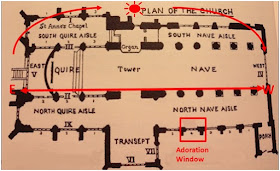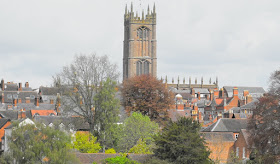It's that time of year again, when I ideally like to choose a Black Magus image for my Christmas card. In the past I've used variants of my Adoration Rood Screen - in whole and details, that worked for 2008 and 2009 and for 2010 I used the three sub-Saharan African Adoration card.
This year I hadn't a clue what to use so devised a particularly poor research technique -I googled The Three Kings followed by Drei Könige and looked at what images turned up. I was not disappointed. I was inundated - many clichés, much kitsch but a few did stand out.....
> A 15th Century Ethiopian Triptych
Madonna and Child triptych from fifteenth century Ethiopia, recently cleaned by the Ethiopian Heritage Fund.
Medium: Painted wooden panel: Size (central panel) approx : 36" x 24" Date: Fifteenth Century from the Monastery of Saint Stephen, Hayq, Ethiopia
This work was a total surprise quite unlike any image in the many hundreds the Google searches presented - visually stunning, ichnographically intriguing - I've seen nothing quite like it before. A nappy haired Jesus set in a medieval triptych frame, in a Greek icon composition surrounded by haloed saints and a donor - extraordinary conflation of concepts and ideas.
I plan to return to this work, to study it in more detail meanwhile I will leave it as a contender for my 2012 Christmas Card image.
> The Three Kings by Richard Hook
The Three Kings by the illustrator and artist: Richard Hook (1938–2010)
Medium: Pen & Ink on Board: Size: 6" x 6" (160mm x 140mm): Date: 1972
The illustration was used in the Look and Learn Annual 1972 and later sold from here
A dramatic, tight, compact work; although the rest of Adoration scene is out of picture its presence is sensed from the united and intense gaze of the three magi all leaning, pressing forward to present their gift to the infant Christ – their gifts and bejewelled fingers indicating where Christ is to be found.
This year I hadn't a clue what to use so devised a particularly poor research technique -I googled The Three Kings followed by Drei Könige and looked at what images turned up. I was not disappointed. I was inundated - many clichés, much kitsch but a few did stand out.....
> A 15th Century Ethiopian Triptych
Madonna and Child triptych from fifteenth century Ethiopia, recently cleaned by the Ethiopian Heritage Fund.
 |
| Fifteenth Century Panel from Monastery of St. Stephen , Hayq, Ethiopia |
This work was a total surprise quite unlike any image in the many hundreds the Google searches presented - visually stunning, ichnographically intriguing - I've seen nothing quite like it before. A nappy haired Jesus set in a medieval triptych frame, in a Greek icon composition surrounded by haloed saints and a donor - extraordinary conflation of concepts and ideas.
I plan to return to this work, to study it in more detail meanwhile I will leave it as a contender for my 2012 Christmas Card image.
> The Three Kings by Richard Hook
The Three Kings by the illustrator and artist: Richard Hook (1938–2010)
 |
| The Three Kings ,1972, Richard Hook (1938- 2010) |
The illustration was used in the Look and Learn Annual 1972 and later sold from here
A dramatic, tight, compact work; although the rest of Adoration scene is out of picture its presence is sensed from the united and intense gaze of the three magi all leaning, pressing forward to present their gift to the infant Christ – their gifts and bejewelled fingers indicating where Christ is to be found.
One composition discussion point is the location of the Black Magus at the head of the trio. The Black Magus image during the Renaissance was conventionally at the rear of the trio, often isolated or separated by space or a barrier
> The 3 Wise Men by Hilke MacIntyre
An edition of 50 painted modern ceramic plaques portraying the three kings:
Medium: ceramic relief, edition of 50: Size: 3 parts, each 11.5 x 5 cm Date: Twenty-First Century
A lovely modern rendition of the three magi by Hilke MacIntyre sadly (for me, not the artist!) it is sold out. I was intrigued that the artist moved the Black Magus around in the group as he hand painted each edition individually.
Interestingly, the MacIntyre's Magi gaze is directly ahead indicating that the viewer is the subject of that gaze or put another way they (we) are the Madonna and Child!
-------------------------------------------------------------------------------------------------------------------
> and the Winner is.....Richard Hook's The Three Wise Men!
..and some after thoughts.....
There were a number of images which didn't make the short list but nevertheless I found interesting:
The Post Office's 1994 Christmas 25p stamp:
Brussels Grand Place 2012 nativity scene:
The nativity scene in my Mum's nursing home's nativity scene which had two Virgins and two Josephs as well as not one Magus but three Black Magi and one white Magus, a very crowded Nativity!
This image wasn't a contender in fact it was a real shock - a blacked up Black Magus - St. Gordian Epimach, Germany receiving Angela Merkel Christmas 2011:
> The 3 Wise Men by Hilke MacIntyre
An edition of 50 painted modern ceramic plaques portraying the three kings:
 |
| The 3 Wise Men, Hilke MacIntyre |
A lovely modern rendition of the three magi by Hilke MacIntyre sadly (for me, not the artist!) it is sold out. I was intrigued that the artist moved the Black Magus around in the group as he hand painted each edition individually.
Interestingly, the MacIntyre's Magi gaze is directly ahead indicating that the viewer is the subject of that gaze or put another way they (we) are the Madonna and Child!
-------------------------------------------------------------------------------------------------------------------
> and the Winner is.....Richard Hook's The Three Wise Men!
In the end it was an easy decision as I was totally enamoured by the drama in the piece, its modernist tension in the compressed picture plane is palpable - it's been my iPad Lock Screen and Wallpaper for the past month.
So, friends and family will receive Richard Hook's The Three Wise Men printed by moo cards, delivered in a festive red envelope with an appropriately themed stamp.....hopefully sometime before the 25th!--------------------------------------------------------------------------------------------------------------------
..and some after thoughts.....
There were a number of images which didn't make the short list but nevertheless I found interesting:
The Post Office's 1994 Christmas 25p stamp:
Brussels Grand Place 2012 nativity scene:
The nativity scene in my Mum's nursing home's nativity scene which had two Virgins and two Josephs as well as not one Magus but three Black Magi and one white Magus, a very crowded Nativity!
This image wasn't a contender in fact it was a real shock - a blacked up Black Magus - St. Gordian Epimach, Germany receiving Angela Merkel Christmas 2011:























